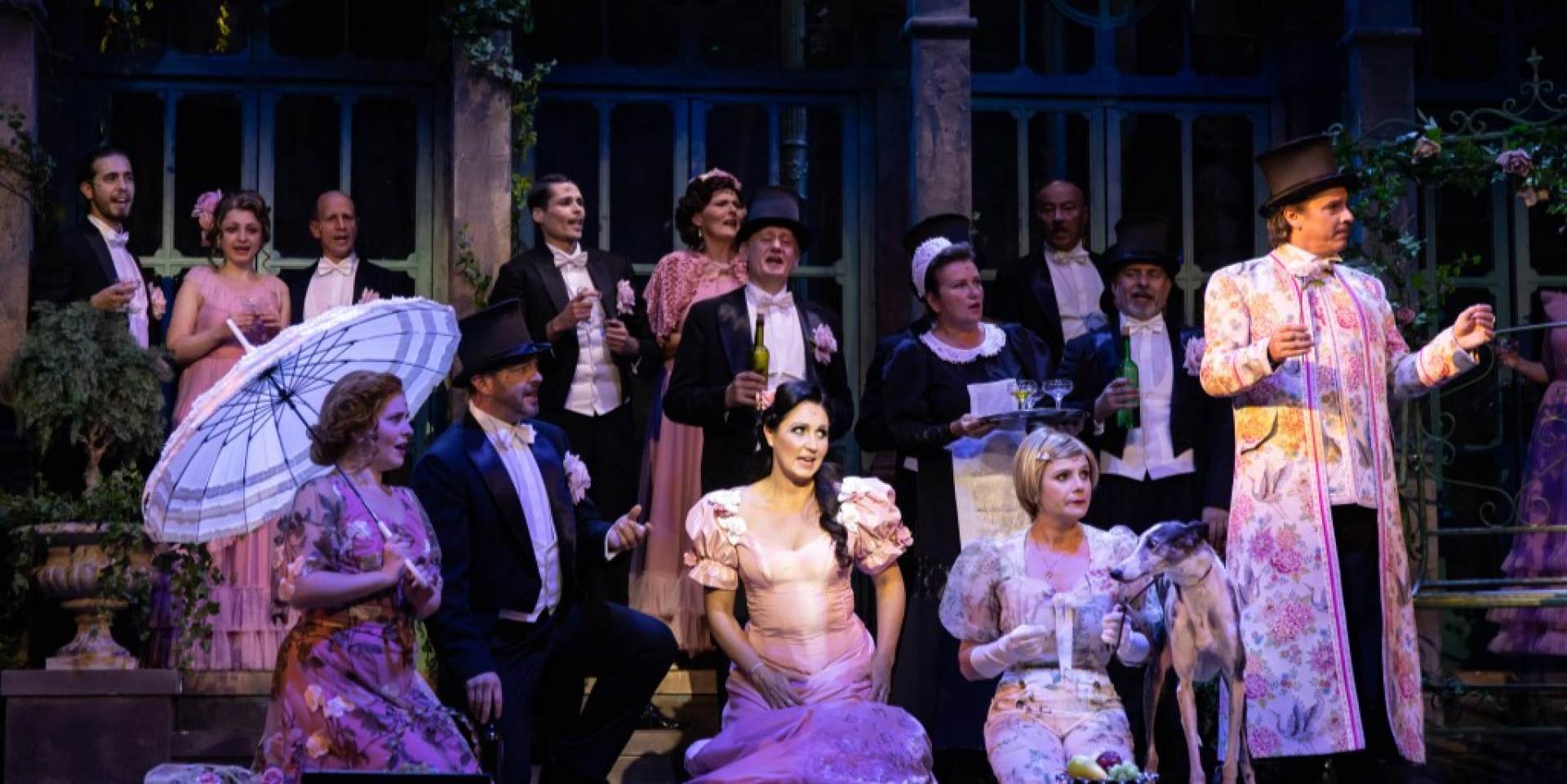Countess Maritza
Mo | Tu | We | Th | Fr | Sa | Su |
Countess Maritza - Emmerich Kálmán
Genre: Operetta
Duration: 205 minutes
Number of Acts: 2
Synopsis
Place: Hungary: the manor and estate of the Countess Maritza
Time: Around 1920.
Manja the gypsy girl flirts with the newly appointed bailiff, Béla Törek. Unknown to anyone, Törek is in fact the impoverished Count Tassilo, who is seeking to earn a living and set aside some cash for the dowry of his sister Lisa. The Countess Maritza, a young widow, unexpectedly arrives at the estate to celebrate her engagement. This 'engagement' is however quite fictitious, an invention intended to put off her numerous followers. The name she has chosen for her suitor, based on her recollection of Strauss' operetta, The Gypsy Baron, is Baron Koloman Zsupán. However, amongst Maritza's guests, to Tassilo's horror, is Lisa, who he instructs to keep their relationship and his identity strictly secret. Maritza is also embarrassed when a genuine Koloman Zsupán materialises, having seen an announcement of his 'engagement' in the press.
Tassilo is heard by the guests singing an air "Komm, Zigány" ("Come, gypsies!"), which he ends with a czardas. Maritza orders him to repeat it; he refuses, and the angry countess announces that he is fired. Manja predicts that The Countess will be very happy in love. "One moon will pass over this Earth and Maritza will find her happiness", she sings. Maritza therefore decides to remain on her estate. She stops Tassilo from leaving and apologises.
Zsupan has meanwhile decided that he prefers Lisa to Maritza, whilst Maritza is increasingly attracted to Tassilo. However, the ageing Lothario Populescu reveals to Maritza Tassilo's identity, and moreover alleges that Lisa is his girlfriend. Maritza in a high temper insults Tassilo, who declares that he will leave. However, before he goes, the repentant Maritza writes him a 'reference' which is in fact a proposal of marriage. The operetta ends with Maritza and Tassilo, and Zsupan and Lisa, engaged.
Program and cast
Mónika Fischl: Countess Marica
Enikő Éva Lévai: Countess Marica
Anita Lukács: Countess Marica
Attila Dolhai: Count Tasziló
Zsolt Homonnay: Count Tasziló
Szilvi Szendy: Liza, the sister
Luca Bojtos: Liza, the sister
Széles Flóra: Liza, the sister
Péter Laki: Baron Zsupán Kálmán
Erdős Attila: Baron Zsupán Kálmán
Viktor Dénes: Baron Zsupán Kálmán
Marika Oszvald: Princess Cecília Cuddenstein Chlumetz
Athina Papadimitriu: Princess Cecília Cuddenstein Chlumetz
Szilágyi Enikő: Princess Cecília Cuddenstein Chlumetz
András Faragó: Prince Moritz Dragomir Populescu
Soma Langer: Prince Moritz Dragomir Populescu
Zoltán Kiss: Prince Moritz Dragomir Populescu
Tamás Földes: Kudelka, chief steward
Tibor Szolnoki: Kudelka, chief steward
Altsach Gergely: Kudelka, chief steward
Attila Bardóczy: Mihály, old hussar
Gábor Melis: Mihály, old hussar
Attila Balogh-Bodor: Mihály, old hussar
Annamária Zábrádi: Manja, the gypsy girl
Dalma Süle: Manja, the gypsy girl
Jakab-Mészáros Edina: Ilka Dombossy
Halasi Bianka: Ilka Dombossy
Illés Kitti: Ilka Dombossy
Pál Péter: Berkó
Gombai Szabolcs: Berkó
Conductor: Gyula Pfeiffer, Péter Dobszay, Zsolt Tassonyi
Imre Kálmán: Composer
Julius Brammer, Alfred Grünwald: Libretto
Zsolt Harsányi: Translator
János Dénes Orbán: Dramaturge
Mónika Szabó: Choir conductor
Gyula Pfeiffer: Musical director
Zsuzsanna Németh: Assistant choreographer
Rebeka Birkenstock: Assistant director
Tamás Bori: Artistic assistant
András Tucker: Artistic assistant
József Dreiszker: Light designer
Krisztina Berzsenyi: Costume designer
Balázs Cziegler: Set designer
Junior Zsuráfszky Zoltán: Choreographer's assistant
Dániel Krizsán: Choreographer's assistant
Yvette Bozsik: Director-Choreographer
Budapest Operetta Theater
History
The history of the Operetta Theatre begins with the name of Károly Somossy who used to run an Orpheum in the building at 17 Nagymező street since 1884. In 1890 he bought the house and had it transformed into an entertainment house by the Felner and Helmer company, which opened in 1894. Its interior design was exalted by all accounts. Then the venture went bankrupt in 1899, Károly Albrech restaurant keeper took over the operation and from 1902 a Variety Show started to work there with the name of Fővárosi Orfeum, under the management of Imre Waldmann.
The Americal theatre entrepreneur, Ben Blumenthal, after having purchased the Vígszínházm also rented the Orpheum in 1922. The refurbished theatre opened its gates on 23 December 1922 first as Fővárosi Színház, a year later taking up the name of Fővárosi Operett Színház.
From 1929 to 1930 the Fővárosi Művész Színház (Arts Theatre) worked there with leadership of Gyula Kabos. From September 1930 the theatre took up again its old name and was lead by Dezső Sebestyén but it was forced to close several times because of the scanty attendance. From 1936 to 1938 it hosted the Arts Theatre of Artúr Bárdos.
After the siege of Budapest the theatre was opened in march 1945 with the popular operetta by Imre Kálmá, the Csárdáskirálynő. This soon became the biggest Hungarian and international success of the play. The theatre was nationalized in 1949, and Margit Gáspár appointed as director. The general renovation of the building had already been decided in 1960 but it was only realized in the second part of the sixties. In 1966 the company moved into the former building of the Petőfi Theatre, and the reconstruction started according to the plans of the Középüettervező Vállalat (Company of Public Constructions). The designers were: Halmi Iván, Pozsay Csaba és Vajda Ferenc. The festive opening was held on 17 April 1971, again with a staging of Csárdáskirálynő. This was the thousandth performance of Imre Kálmán’s operetta.
Imre Halasi, who used to be the manager of the theatre from 1996 to 2000, changed the name of the theatre form 1. January 1998. Since then it is called Budapesti Operettszínház (Budapest Operetta Theatre). Another reconstruction of the building can be tied to the name of Halasi, the aim of which was the restoration of the original milieu. The designer, Mária Siklós, tried to free the building from the construction errors that got there during the several earlier reconstruction.
In March 2002 a studio theatre for 100 people was inaugurated, the so called Storage Room Theatre situated in the theatre’s wing in Mozsár street.
Architectural description
The unique character the theatre comes from the interesting features of the plot division. The main facade and the entrance of the Budapest Operetta Theatre opens from the Nagymező Street, however the functions of the theatre are built in to the inside courtyards framed by houses between the Andrássy, Nagymező and Mozsár streets. Therefore the mass of the auditorium and the flyloft is not perceptible from the street.
The two-storey mass of the main facade was built at the turn of the century, according to the plans of the famous Viennese theatre designer duo, Ferdinand Fellner and Herman Helmer. The entrance axe is surrounded at the entire height of the building by arched closed pediment. The entrance projection is articulated with two opening axes. The windows on the first floor are squared closed, while those on the second floor are arched. On the attics closing this part of the building on the complete with of the projection stands a lyre indicating the function of the building.
The side wings are articulated with three opening axes and pilasters, which surround the first and second floors. Between the ground and first floor a dividing edge and balusters run around. The first floor openings are arched, while those on the second floor are squared, closed with decorative frame and keystone. The ground floor surface is horizontally pointed. The wall plane of the storeys is punch coloured; the pilasters, the sides, the ornaments and the window frames are white.
The auditorium is fan-shaped with balconies on the first and second floor. The stage is framed with accented proscenium wall and proscenium boxes.

 EN
EN DE
DE IT
IT FR
FR ES
ES RU
RU JP
JP RO
RO
 Seating plan
Seating plan 

